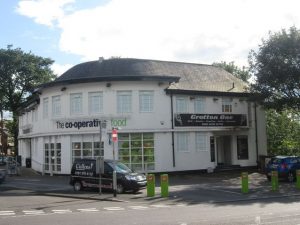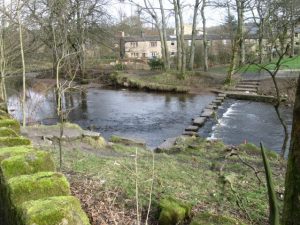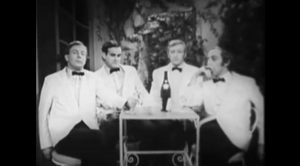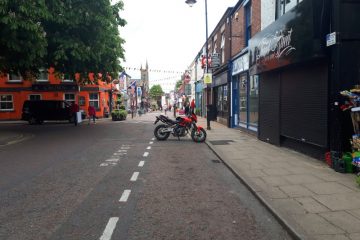184: Oldham to Huddersfield (starts at Manchester)
Operator: First Manchester
Frequency: Hourly (Mon-Sat), Every 2 hours (Sun)
Time: 1 hour 10 mins
Date of Trip: 12/6/18
Getting out of Oldham is like a bus assault course. Shoppers scatter as the double decker sashays its way through what looks for all the world like a pedestrian zone, with a crazy paving patio where there’d normally be a road. It loops around until it eventually reaches a definable way out at Oldham Mumps.
There don’t appear to be any more interchanges in the UK which are named after infectious viral diseases, so we’re cruelly denied a Runcorn Rubella or Malmesbury Manflu. More’s the pity.
A steady climb out of town along the A669 brings us in short time to a sign for ‘Historic West Yorkshire’, and a reminder that the older generation in Saddleworth are still huffy about being lumped in with Lancashire in the 1974 boundary changes. Geographically and linguistically, it’s beyond doubt that the area belongs on the wetter side of the Pennines, and with its churchgoers traditionally being under the auspices of the Parish of Rochdale, it’s bizarre that it would ever have been associated with anything other than the Red Rose.
Grotton, in particular, has a special place in my heart. It’s barely a suburb, just a minor crossroads with a smattering of shops around its crux, but in the heady summer of 1996, the fruit and veg shop played a defining part of my youth.
Aside from a brief and regrettable career as a paperboy – which culminated in me throwing away a luminous satchel half filled that day’s Manchester Evening News behind a bush, thanks to a stand-off with an alsatian and then not being able to find Gathurst St – my first job was walking around shops, pubs and factories, hawking clothes out of a holdall.
 Revision Is For Wimps
Revision Is For Wimps
I was actually working full time before I left school. My mum, deciding that GCSE revision was for wimps, pointed to an advert in the local free paper which had the words ‘AUSTRALIA!‘ in bold font, with “10-15 people needed to start urgently. Full training given.” just underneath.
Before I had the chance to protest, I was pounding the streets of Stockport on a training day, and was offered the role of travelling salesman at 061 Wholesale. I’d be making £2 or £3 per item sold, commission only, so I’d better be good. Graciously, I was allowed the day off if I had any exams.
My fateful day in Oldham came a couple of months in, and had been a travesty in which I’d traipsed up from the town centre in sweltering heat and too much polyester. After trying my luck in every establishment in Lees and Springhead, I’d sold one t-shirt in a fabric shop and made a grand total of £3. £2 of which I’d spent on my dinner.
On to Grotton then. The butchers, who are always a jolly bunch despite being their overalls being covered in blood, said no to my wares. The customers in the hairdressers weren’t interested, either. The assistant in the fruit and veg shop, however, was surprisingly drawn to a garish tiger-striped top, of which the entire workforce of 061 Wholesale had managed to shift less than 20 between them in the week or so we’d had them.
“Do you mind if I try it on?” said the assistant, who was probably two or three years older than me.
“Yeah, course you can.” I replied, taking the item out of its wrapper and handing it over.
She presumably hadn’t had many customers that day, as without so much as checking for any passing footfall, she unbuttoned her blouse, draped it over the counter and popped the orangey-yellowy-browny t-shirt over her head.
“How does it look?” she asked.
“Yep, yeah,” I said, eyes darting anywhere but on her, “it definitely fits.”
“How much is it?”
“That one’s just £8.” which was still far, far too much.
“Can I have it?”
“…erm…”
“Go on, just for me.”
I never did go back to Grotton, but the fruit and veg shop is long gone, presumably on the grounds of public decency.
 A Duck Takes Aim
A Duck Takes Aim
Back to the present day, and once we’re over the brow, the Pennines proper are suddenly right in front of us. This includes the hills around Dove Stones Reservoir which are the scourge of non-league football players from miles around, who are sent to shuttle up and down them until their pre-season timber drips off them.
We’re greeted in Uppermill, the main town in Saddleworth, by a couple of sets of geese and their wobbly goslings having a mooch around a patch of grass by the High St. Of course, despite pitching up in the middle of town, the mothers are still as protective over their progeny as anywhere else, and every passer by gets a menacing slow-motion quack of warning.
Incidentally, the last time I was in Uppermill, I was shat on by a mallard. It was also the only time I’ve ever bounded across a stretch of stepping stones, and although the River Tame isn’t exactly at its most tempestuous in these upper reaches, you’d still get a comprehensive drenching if you put a foot wrong. Sadly for this blog, I made it across and back again in one dry piece.
Full steam ahead through to Diggle, and an ear-popping ascent up the moors along Huddersfield Road, which is basking in a rare cloudless day. Scattered copses huddle inside wind-funnelling valleys, the stubbier trees taking the brunt of the prevailing elements, while their lankier siblings lap up the calmer conditions behind them. It’s always a treat to leave civilisation behind, and although I don’t necessarily want to use my waning energy levels walking in the hills, they’re always great to be among and wrap my eyes around.
A brilliant and verdant view back down towards Uppermill and Greenfield eases its way off to the right, with numerous mystery tracks skirting away to unseen sheep farms, whose livestock must be right up there with the hardiest in the UK.
A cutting at the summit marks the border between Lancashire and West Yorkshire, the north western tip of the Peak District, and also the point where the Standedge Tunnels pass a few hundred feet below the surface.
It’s a complex of three railways tunnels (two of them now disused), which were bore out in the mid-19th century to accompany the existing Huddersfield Narrow Canal tunnel. 5,000m long, almost 200m underground, and taking the best part of 16 years before it was open for business, it was beset by engineering headaches and funding problems during its construction. Thomas Telford rode to the rescue on the planning front in 1807, and work accelerated until its eventual completion four years later.
You’d think that with all the hoohah, it would’ve been a magnet for cotton mills looking to transport their goods cross-border, but only around 40 narrowboats per day braved the dark guts of the void. In order to cut costs, no footpath was constructed, so all vessels had to be shoved along by a couple of ‘leggers’, who inched their cargo forward by pushing against the walls of the longest canal tunnel ever built in Britain with their feet. It could take upwards of three hours with a full load.
Of course, railways soon supplanted canals, and this three mile section of waterway was eventually left to rot between 1944 and a restoration project which saw it reopen in 2001. Today’s equivalent of leggers are the electric tugs which drag boats through to Marsden, as the lack of ventilation apparently doesn’t mix well with the fumes from the diesel engines that most canal boats are fitted with these days.
 I’d Get Up Half An Hour Before I Went To Bed
I’d Get Up Half An Hour Before I Went To Bed
On the other side of Pule Hill is what used to be the Great Western Inn. It looks like it’s a private residence these days, but has most of the trappings pointing to it still being a going concern, such as the pub sign and car park. Whoever lives there no doubt has a steady stream of baffled walkers scratching their beards outside, taunted by memories of Sunday lunches past, or cursing their slightly out of date guidebooks.
They needn’t fret about being stranded in this desolate stretch of moorland, though, as another pub, the Carriage House is a couple of hundred yards down towards Marsden. Quite how two boozers managed to survive out here in the wilds seems baffling, until you realise that they’re right by the Pennine Way, and the latter has a camp site attached as well as pushing a sideline in hearty Turkish food. [Update July 2020: the Carriage House has now gone, too. It became a ‘party house‘ holiday let after the pub’s owners retired.]
We’re soon into Marsden, where the tunnel’s Visitor Centre ushers you in. It’s a place I’ve never jumped off in before, which looks like an increasingly daft decision each time I pass through. It’s exactly how you’d want a quintessential Yorkshire town to look, with its defiant terraces, understated grandeur, and almost reluctant cuteness. Next time, next time…
Straddling both banks of the River Colne a couple of miles downstream, Slaithwaite is more stoic in its outlook. With fewer visitors than Marsden and a no-frills approach to existence, it’s got to be where Monty Python’s Four Yorkshiremen were dragged up and beaten with leather belts and broken bottles and sawn in half with bread knives. In fact, the sketch pre-dates The Pythons by at least a couple of years, with the original version being aired in 1967 on the At Last The 1948 Show, featuring Tim Brooke-Taylor (who I once inexplicably got compared to by a Hare Krishna in London) and a magnificently taciturn turn from Marty Feldman.
It also nails the local trait of its pronunciation sounding nothing like how it’s written. Even then, there are multiple camps. My mate, Effin’ Nicholls – so called because of his prodigious use of profanity – can trace his Methodist roots here and calls it ‘Slew-it’, although others insist that it’s ‘Sla-wit’. It apparently depends on how lah-de-dah you are, although I don’t know which way round is which.
We’re soon descending through Huddersfield’s outer reaches and into the town itself. The bus station tries to look modern, but with a few stands being closed for maintenance, the veneer peeled away a long time ago. Still, it’s busy on this Tuesday dinnertime, and as we’ve got another bus to catch, we’re in the right place.
To Hebden Bridge!



2 Comments
Nick · July 9, 2018 at 10:03 pm
A fascinating read, but I must correct you on one thing: Standedge has never been Lancashire’s border. Before 1974, the West Riding of Yorkshire included all of Saddleworth, hence the heritage border stones in Lees on the A669 and at Grains Bar on the A672. Post 1974, Saddleworth is in Greater Manchester, which is the county that has its border with West Yorkshire at Standedge cutting. As lovely as Lancashire is, it never made it this far and never will. As you may have guessed, I live in Saddleworth – a relative newcomer, but one appreciative of its unique county allegiance.
admin · July 11, 2018 at 7:54 am
Excellent point well made, Nick! The waters are muddied by nobody (or at least, few very people) in Oldham, Rochdale, Wigan or any of the other satellite towns referring to themselves as being from Greater Manchester. That said, although GM is pretty much universally shunned and most would consider that part of the world to be Lancashire, you are spot on 🙂
Spare a thought, too, for poor old Tameside, which is split between three different postal areas: Manchester (Droylsden, Denton, Audenshaw), Cheshire (Hyde, Dukinfield, Stalybridge) and Lancs (Ashton & Mossley).